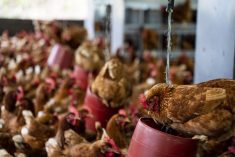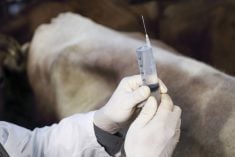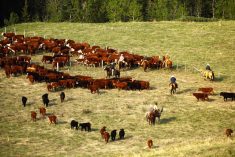Despite intense scrutiny, there’s little evidence that antibiotic use in the cattle industry is increasing resistance to human medicines.
But it could be causing increased resistance to antibiotics used to treat cattle, say two experts.
There’s no question that using antibiotics increases the odds of bacteria becoming resistant, said Reynold Bergen, science director of the Beef Cattle Research Council.

“Antimicrobial use — whether we are using it in humans or pets or livestock, agriculture or horticulture or beekeeping — is going to increase antimicrobial resistance,” Bergen said during a recent research council webinar.
Some antibiotics used in livestock are closely related to antibiotics used in human medicine, and antibiotic resistance can be transferred between different types of bacteria, he said.
“There’s concern that all of these factors can add up to a reduction in the efficacy of drugs that are used in human medicine and that’s actually where the big question mark is,” said Bergen.
Antibiotic resistance is a naturally occurring phenomena, and even bacteria never exposed to antibiotics have been found to develop resistance.
Read Also

Mosquito-borne virus could be devastating to sheep breeding operations
Cache Valley virus, a mosquito-borne disease that infects small ruminants, could be a devastating hit to small operations.
“Antibiotic resistance is natural, but if we add extra antibiotics through the various ways they are used, we can really speed up the rate at which antibiotic resistance develops,” said Bergen.
But so far, there’s very little evidence antibiotic use in the cattle industry is posing a threat to human medicines. According to work done by the Canadian Integrated Program for Antimicrobial Resistance Surveillance, there is next to no resistance to antibiotics that are classed as “high importance” in human medicine, and more resistance to drugs that are “less important” in human medicine.
“In the cattle side, the antimicrobial resistance is looking very, very good,” said Bergen. “Any other livestock sector in Canada would be proud to have results that look this good.”
The “very high importance” and “high importance” drugs account for only 20 per cent of all drug sales in the cattle industry.
“When we look at the human side of things, it’s close to 80 per cent,” said Bergen. “Chances are, if these drugs aren’t working in human medicine, it’s because of the way they are used in human medicine.
“There is no evidence that antibiotic resistance in Canadian beef cattle production is causing the antibiotics in human medicine to be less effective and that is in spite of the fact that people are really looking to see if that exists.”
But that doesn’t mean all is well.
Cattle producers and feedlot operators used to consider antibiotic use as a right — but they need to realize it’s a privilege, said Dr. Craig Dorin, veterinarian with Veterinary Agri-Health Services in Airdrie.
“Society is going to review how we do this and they’re going to have expectations of us,” he said on the webinar. “And so we need to have a mind shift on how we approach our use of these products so we can defend that we are using them prudently and in a sustainable manner.”
More veterinary oversight, fewer over-the-counter antibiotics, and the removal of growth promotion claims are all being phased in over the next couple of years, but cow-calf producers need to rethink their management approach. Despite the rising concerns about antibiotic resistance, some producers are still using antimicrobials prophylactically.
“With the values of calves as high as they are, people don’t want to lose them, so we are hearing that people are using antibiotics inappropriately — when the animals might need treatment as opposed to when they know they need treatment,” said Dorin.
Most feedlots have stringent protocols for antimicrobials and pen riders are given extensive training in disease recognition. However, some feedlots treat all high-risk calves, whether or not they are sick. This has reduced cases of respiratory diseases and death loss, but it may not be a sustainable practice, said Dorin.
“The question we have is if we can defend the use of this long term,” he said. “Is society going to allow us to use antibiotic products on animals that might get sick if they aren’t currently sick?”
A 2014-15 survey of feedlots conducted by Alberta Agriculture and Forestry and Alberta Beef Producers found some resistance to antibiotics. It also found multi-drug resistance was increasing.
“Antimicrobial resistance does exist, it’s an issue we face and the question is whether it’s going to be a growing issue or something we can control,” said Dorin.
















